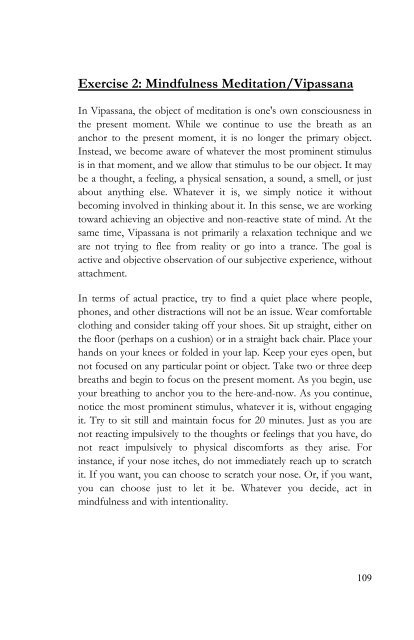Introduction to Mindfulness - Dean Amory
Art and Benefits of Mindfulness Meditation
Art and Benefits of Mindfulness Meditation
Create successful ePaper yourself
Turn your PDF publications into a flip-book with our unique Google optimized e-Paper software.
Exercise 2: <strong>Mindfulness</strong> Meditation/Vipassana<br />
In Vipassana, the object of meditation is one's own consciousness in<br />
the present moment. While we continue <strong>to</strong> use the breath as an<br />
anchor <strong>to</strong> the present moment, it is no longer the primary object.<br />
Instead, we become aware of whatever the most prominent stimulus<br />
is in that moment, and we allow that stimulus <strong>to</strong> be our object. It may<br />
be a thought, a feeling, a physical sensation, a sound, a smell, or just<br />
about anything else. Whatever it is, we simply notice it without<br />
becoming involved in thinking about it. In this sense, we are working<br />
<strong>to</strong>ward achieving an objective and non-reactive state of mind. At the<br />
same time, Vipassana is not primarily a relaxation technique and we<br />
are not trying <strong>to</strong> flee from reality or go in<strong>to</strong> a trance. The goal is<br />
active and objective observation of our subjective experience, without<br />
attachment.<br />
In terms of actual practice, try <strong>to</strong> find a quiet place where people,<br />
phones, and other distractions will not be an issue. Wear comfortable<br />
clothing and consider taking off your shoes. Sit up straight, either on<br />
the floor (perhaps on a cushion) or in a straight back chair. Place your<br />
hands on your knees or folded in your lap. Keep your eyes open, but<br />
not focused on any particular point or object. Take two or three deep<br />
breaths and begin <strong>to</strong> focus on the present moment. As you begin, use<br />
your breathing <strong>to</strong> anchor you <strong>to</strong> the here-and-now. As you continue,<br />
notice the most prominent stimulus, whatever it is, without engaging<br />
it. Try <strong>to</strong> sit still and maintain focus for 20 minutes. Just as you are<br />
not reacting impulsively <strong>to</strong> the thoughts or feelings that you have, do<br />
not react impulsively <strong>to</strong> physical discomforts as they arise. For<br />
instance, if your nose itches, do not immediately reach up <strong>to</strong> scratch<br />
it. If you want, you can choose <strong>to</strong> scratch your nose. Or, if you want,<br />
you can choose just <strong>to</strong> let it be. Whatever you decide, act in<br />
mindfulness and with intentionality.<br />
109

















